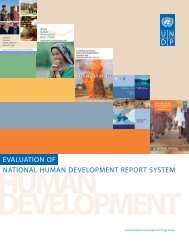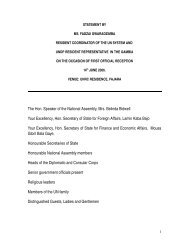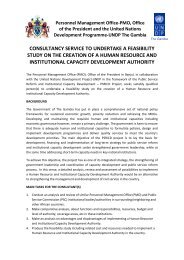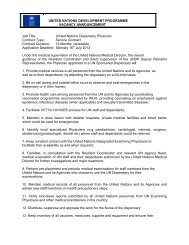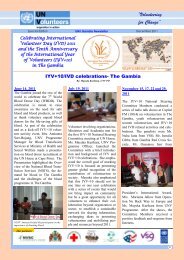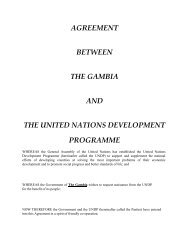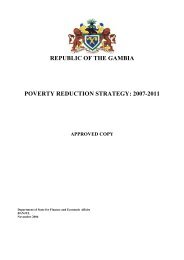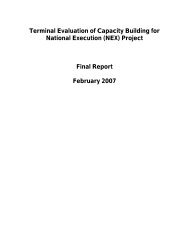Introduction - UNDP The Gambia
Introduction - UNDP The Gambia
Introduction - UNDP The Gambia
You also want an ePaper? Increase the reach of your titles
YUMPU automatically turns print PDFs into web optimized ePapers that Google loves.
________________________________________________________________________________________________________________________<br />
• lack of incentives, motivation and<br />
commitment resulting in increasing<br />
attrition levels<br />
• lack of resources<br />
• poor utilisation of technical assistance<br />
personnel<br />
• lack of effective coordination of policy<br />
and programmes<br />
• institutional bottlenecks and rigidities<br />
• non-adherence to strict governance<br />
practices<br />
• absence of result-based management<br />
which relates pay and incentives to<br />
performance and output.<br />
2.6.1 Lack of Incentives, Motivation<br />
and Commitment<br />
<strong>The</strong> erosion of the earning power of the<br />
average public servant, coupled with an acute<br />
sense of insecurity of tenure, seriously<br />
undermines commitment, motivation,<br />
productivity and adherence to an ethical code<br />
of conduct. An examination of “Civil Service<br />
Pay Scale”, ie total remuneration package<br />
(pay and allowances) reveals that for many<br />
years the level of increase has been well<br />
below the mounting cost of living<br />
index. Table 7 establishes a comparison of<br />
the first four grades of the structures of the<br />
public enterprises and the civil service.<br />
Table 7: Comparison of civil service and parastatal pay scales<br />
Grade Civil Salary Grade Public Differential<br />
Service after 20% Public Enterprises<br />
Award Enterprises Structure Salary<br />
D D D<br />
1 base point 6804 p.a SS III base point 10, 200 3396<br />
top of grade 8232 p.a top of grade 12, 900 4668<br />
2 base point 8388 p.a SS III base point 10, 200 1812<br />
top of grade 9816 p.a top of grade 12, 900 3084<br />
3 base point 9960 p.a SS II base point 13, 200 3240<br />
top of grade 11,640 p.a top of grade 18, 200 6960<br />
4 base point 11808 p.a SS II base point 13, 200 1392<br />
top of grade 14832 p.a top of grade 18, 600 3768<br />
Note: PA means salary per annum<br />
Table 7 shows wide disparities between<br />
parastatal and civil service pay, with the third<br />
grade in the latter almost corresponding to the<br />
lowest grade in the former. <strong>The</strong> disparities at<br />
the remaining grades are even wider. When<br />
compared to salary levels in the private and<br />
NGO sectors, the disparities become even<br />
much wider.<br />
Apart from increasing salary levels<br />
substantially through a reduction of<br />
vacancies, wastage and redundant labour,<br />
Government needs to introduce measures to<br />
enhance productivity, instil security in tenure<br />
and promote career development.<br />
<strong>The</strong> erosion of the earning power of the<br />
average public servant, coupled with an acute<br />
sense of insecurity of tenure, seriously<br />
undermines commitment, motivation,<br />
productivity and adherence to an ethical code<br />
of conduct.<br />
Several African countries have increasingly<br />
adopted the “New Public Management”<br />
(NPM) approach to stimulate productivity<br />
and high quality performance. <strong>The</strong> NPM is<br />
seen as a body of managerial thought based<br />
on ideas generated from the private sector and<br />
imported into the public sector. <strong>The</strong><br />
________________________________________________________________________________________________<br />
Building Capacity for the Attainment of the Millennium Development Goals in <strong>The</strong> <strong>Gambia</strong> National Human Development Report 2005<br />
21




